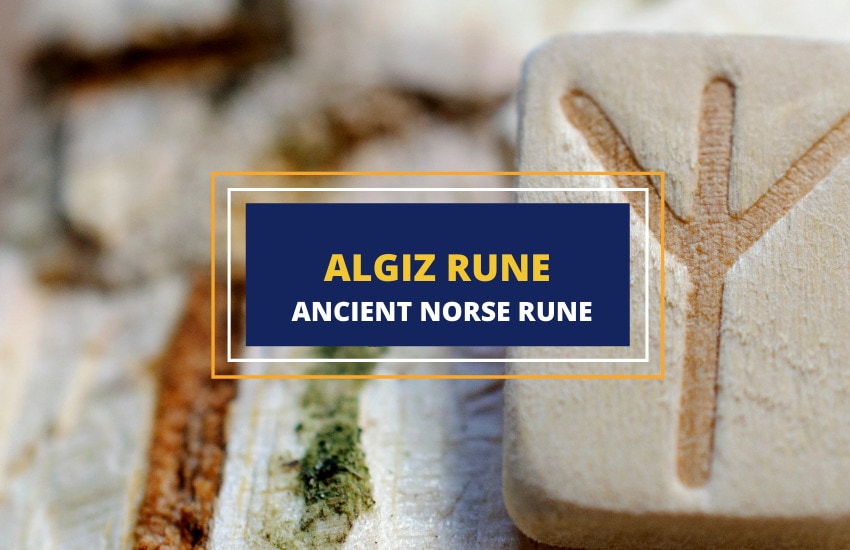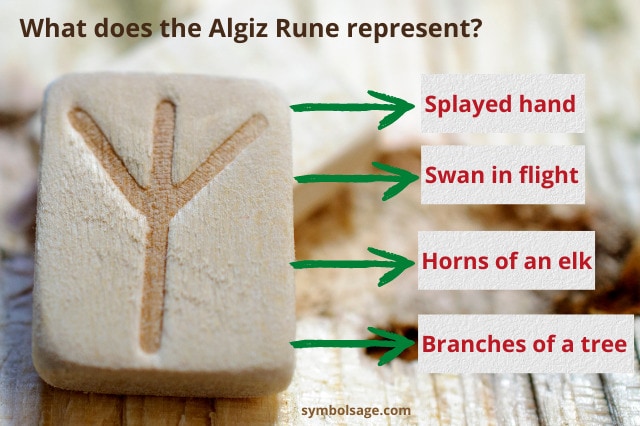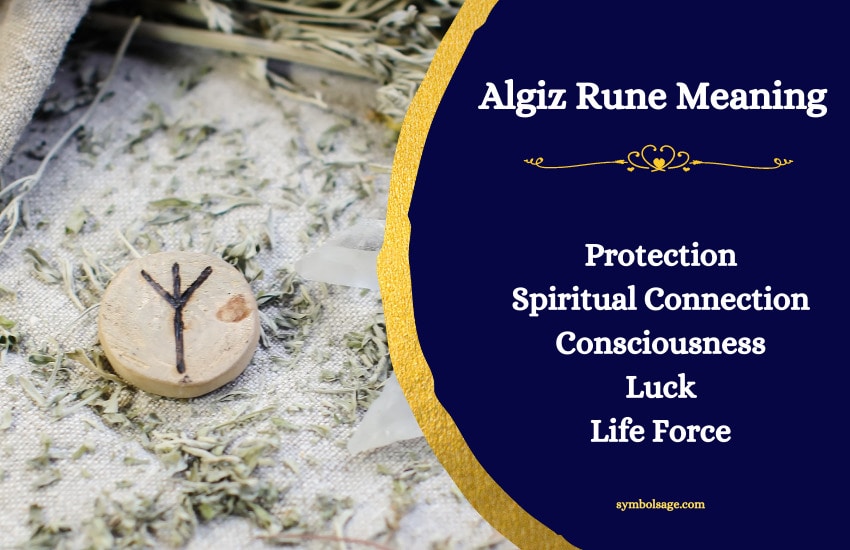
Table of Contents
Also known as Elhaz, the Algiz rune is one of the characters of the runic alphabet used by the Germanic peoples of Northern Europe, Scandinavia, Iceland, and Britain around the 3rd century to the 17th century CE. The word rune comes from Old Norse and means secret or mystery, so it’s widely believed that the ancient symbol carried magical and religious significance for people who used them.
Meaning and Symbolism of the Algiz Rune
The Algiz rune is known by many names, including the Germanic elhaz, the Old English eolh, and the Old Norse ihwar—only in runic inscriptions. It’s believed that the ideographic representation of the symbol is derived from a splayed hand, a swan in flight, the horns of an elk, or even the branches of a tree. Here are some of its meanings:

A Symbol of Protection
The Algiz rune is considered the most powerful rune of protection. Its symbolism is derived from the name of the rune itself, as the Proto-Germanic term algiz means protection. Also its ideographic representation may have been derived from a basic sign of defense—a splayed hand.
In Gothic, the now extinct East Germanic language used by the Goths, the term algis is associated with the swan, which has been connected with the concept of the valkyrjur—mythical beings who fly by means of swan feathers. In mythology, they are protectors and life givers. In the ancient times, the symbol was carved into spears for protection and victory.
The Algiz rune also resembles the elk sedge, a water plant known as elongated sedge. In fact, the Germanic term elhaz means elk. In an Old English rune poem, the elk-sedge flourishes in the water and grows in marshy regions—yet it wounds anyone who tries to grasp it, associating it with defense and protection.
The Gothic term alhs, meaning sanctuary, has been related to the Algiz rune as well. It’s believed to be a protective grove dedicated to gods, so the rune also has the protective power of the divine—the Alcis twins. In the Germania by Tacitus, the divine twins were sometimes depicted as being joined at the head, as well as represented as elk, deer, or hart.
Spiritual Connection and Consciousness
From an esoteric perspective, the Algiz rune represents the spiritual connection between gods and humanity, as the Germanic peoples communicate with their gods through the sacred posture of the rune—or stodhur. The rune is also associated with the Bifrost, the three-colored bridge of Norse mythology protected by Heimdallr, which connects Asgard, Midgard, and Hel.
In magic, the Algiz rune is used for communication with other worlds, especially Asgard, the world of the Aesir or Norse gods, including Odin, Thor, Frigg and Baldr. The rune is also used for communication with the cosmic wells of Mimir, Hvergelmir and Urdhr. It’s also thought to be the force used by Heimdallr, the watchman of gods, in his aspect as a guardian of Asgard.
Luck and Life Force
In some contexts, the Algiz rune can also be associated with luck and life force, as it’s a symbol of the hamingja—a guardian angel who accompanies a person and decides for their luck.

The Algiz Rune in History
It’s widely believed that the runes were once sacred symbols of the Bronze Age magicians and priest, which were eventually incorporated into a system of writing, each with corresponding phonetic value. Later, the Algiz rune was used by nationalists to strengthen their claims to the supposed superiority of their causes, which gave it a bad reputation. However, by the 20th century, there was a revival of interest in runes, which has resulted in their popularity today.
The Algiz Rune and the Runic Alphabet
The Algiz is the 15th character of the runic alphabet, with the phonetic equivalent of x or z. Also called futhark, the runic writing is derived from one of the alphabets of the Mediterranean region. The symbols have been found on most ancient rock carvings in Scandinavia. They have also been derived from the Phoenician, classical Greek, Etruscan, Latin, and Gothic scripts.
In Medieval Period
In The Icelandic Rune Poem, the Algiz rune appears as the rune Maðr, and described as man’s pleasure, earth’s increase, and ship adorner. It implies that people in the medieval Iceland attributed magical power to the rune.
The epithets are somewhat vague, but many speculate that the Algiz rune was once significant to farmers and sailors. It’s thought that the ancient Icelandic mariners decorated their ships with literal runes to protect themselves and their ships from evil.
In the Iconography of Nazi Regime
In the 1930s, the runes became sacred emblems of Nordic cultural nationalism, which resulted in their addition as a symbol of the Nazi regime. Nazi Germany appropriated many cultural symbols to represent their idealized Aryan heritage, such as the Swastika and the Odal rune, as well as the Algiz rune.
The Algiz rune was featured on the SS’s Lebensborn project, where pregnant German women were regarded as racially valuable and encouraged to give birth to their children in order to increase the Aryan population.
During World War II, foreign children of Aryan appearance were kidnapped from the countries of occupied Europe in order to be raised as Germans. The word Lebensborn itself means Fount of Life. Since the Algiz rune was used in the campaign, it became associated with the regime’s racial ideology.
In the 20th Century
In the 1950s and 60s counterculture movements, a group of people known as hippies influenced public interest in mysticism, including the theories on runes. Several books were written to examine the paranormal in the fields of neuroscience and psychology, like the New World of the Mind by Joseph Banks Rhine.
Later, authors delved towards mysticism. An example is Colin Wilson who wrote The Occult, which popularized the occult use of the runes. By the mid-1980s, there were neo-pagan practitioners, so the symbolism of the Algiz and other runes became more significant.
The Algiz Rune in Modern Times
Because of the symbolic meanings of the Algiz rune, many use it in modern paganism, magic, and divination. In fact, the casting of runes is a popular practice, where each stone or chip marked with the symbol is laid out in patterns like tarot cards. Like many ancient symbols, runes also made their way into pop culture, and have been featured in several fantasy novels and horror films.
In Festivals
In Edinburgh, Scotland, the Algiz rune serves as an aesthetic motif and a ritual element in certain festivals. In fact, runes are incorporated into the regalia of Beltaners who are members of the Beltane Fire Society, a community arts performance charity that hosts several Celtic festivals.
However, the use of the Algiz rune at the Edinburgh Beltane festival became controversial, especially since the festival has Celtic roots and the rune itself is a Germanic symbol.
In Pop Culture
In the horror film Midsommar, runes were used to convey certain scenes secretive meanings. The Algiz rune was featured in reverse, with the prongs pointing down. It’s said that it was one of the rune stones worshipped by an elderly couple before their suicide. Based on the context in the film, the reversed rune meant the opposite of the usual symbolism of the Algiz, so it suggested danger instead of protection.
In Brief
The Algiz rune has gained different associations over the centuries. In Nordic culture, it’s regarded as a rune of protection and represents the spiritual connection of gods with humanity. Unfortunately, it also became associated with the racial ideology of Nazi regime. Since it remains significant in spirituality and neo-pagan religions, it has shed some of this negative association.








